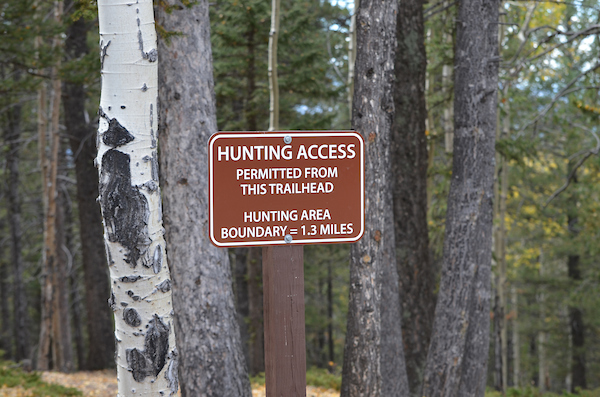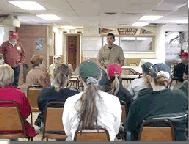By Jim Bulger, Hunter Outreach Program Coordinator
Turkey hunting in Colorado is growing in popularity each year. More and more hunters are finding the challenges provided by the long beards to be one of their most exciting hunts. There is no greater thrill than the resounding gobble of a mature tom turkey, heading to your call on an early spring morning. With the growth of popularity and number of hunters in the field each year, safety in the field has become an important aspect of the hunt and deserves some discussion each year before we head off to chase that elusive gobbler.
 Hunting remains one of the safest forms of recreation, but turkey hunting has some inherent risks that need to be considered each year before we begin the season. First, let’s consider some national statistics that should catch your attention:
Hunting remains one of the safest forms of recreation, but turkey hunting has some inherent risks that need to be considered each year before we begin the season. First, let’s consider some national statistics that should catch your attention:
Nationally, nearly one hundred turkey hunters are injured each year (The National Wild Turkey Federation estimates that there are around 3 million turkey hunters in the U.S.).
Turkey hunting is the second leading category for hunting accidents. Turkey hunting accidents in Colorado are rare, in no small part because of our hunter education standards and the wealth of safety information available.
The overwhelming majority of turkey hunting incidents involve hunters shooting other hunters.
The last point above is the one that needs to be fixed up front. We can prevent injuries in the field by following some simple rules about hunting the spring gobblers. So let’s talk about some things that you can do to enjoy the spring hunts and remain safe in the field.
Educate Yourself
Hunters need to do their homework and understand the habits of the turkey and the habitat they use in the spring. In Colorado, we have two species of wild turkey, Rio Grande and Merriam’s. While both are wild turkeys, their habits and where they live are very different. Before the season, attend a turkey hunting seminar; get a book or DVD, and do some research on the internet about the turkey you intend to hunt. A smart hunter who has done their homework will be a safe hunter in the field.
 Properly Prepare
Properly Prepare
Turkey hunting takes preparation, just like any other type of hunting. Once you have picked an area to hunt, scout it before the season begins. Look at the terrain to become very familiar with it. You will be walking that same terrain in the dark on opening morning and you need to know all you can about the boundaries, trails, and hazards in the area. Make sure to know where the boundaries of private land are, and if hunting the edges of a game management area, make sure you know those landmarks as well.
A second part of preparation is getting your equipment ready to go. You will need to pattern your shotgun with the choke and ammunition you intend to use for the hunt. Knowing where your gun shoots can make all the difference in success or failure when that strutter comes to call. You should make sure you know exactly how your gun will perform at various distances to a target and only take the shot that will ensure a safe harvest. A big part of knowing your shotgun is the safety aspect. With a full choke or super full choke used in hunting turkey, the lethal range of the gun is increased, so make sure you have a safe backstop and the area beyond the target is clear. Patterning your shotgun will require several different loads of ammunition to determine the one which works best in your particular gun and choke combination. Purchase several different shells from different manufacturers and see which one works best. The size of shot is an important aspect of the pattern and safety as well. I strongly believe a shot size of number 4 or 5 is suitable for a turkey and the potential for injury to another hunter is reduced when using a smaller shot size.
Finally, take a look at the amount of gear you intend to carry in the field. A vest or backpack is a handy item that will reduce the amount of things you have to carry in your hands to your hunting location. If you use a decoy, transport it in the vest or the pack, do not carry it in your hands in the field and become a target for a hunter who has not read this article.
Prevent an Accident
 The best way to prevent an accident in the field is to do the things I have discussed above and add a bit of hunting strategy to the plan. As you prepare for the hunt, consider these ten things and incorporate them into your hunting plan in the field:
The best way to prevent an accident in the field is to do the things I have discussed above and add a bit of hunting strategy to the plan. As you prepare for the hunt, consider these ten things and incorporate them into your hunting plan in the field:
Avoid wearing clothing that has the same colors as a turkey. Red, white, and blue are the colors found in wild birds.
Protect your back. Find a tree or rock outcropping to back up against and protect your backside. This may protect you from the pellets fired by another hunter as well as provide cover for the area you cannot easily see if another hunter is approaching your location.
Camouflage from head to toe. Not only will this aid in your attempt to remain unseen by an approaching gobbler, but it will keep you hidden from another hunter who is walking in your area. If another hunter is approaching your position, remain still and call to the hunter in a clear voice. Do not whistle or use a call. Announce your presence without movement.
Place decoys in a location that you can see the gobbler approaching to your “gun side” to prevent having to move to make a shot. This placement also prevents you from being in a direct line with the decoy if an unseen hunter attempts to shoot your decoy.
When traveling to a hunting location, transporting decoys or a harvested bird, wear hunter orange (a vest or hat). Place the harvested bird in a game bag or wrap the bird in an orange vest. DO NOT sling a harvested bird over your shoulder and walk out of you hunting area.
Always look beyond your target to insure the area is safe. Do not shoot sky-lined birds, not even with a shotgun.
Clearly identify your target as a legal bird. In the spring turkey season, a bird must have a visible beard. Do not shoot at movement in the brush, even if you hear a gobble.
Do not carry a loaded firearm in your vehicle. Completely unload the firearm before traveling.
Inspect your ammunition before your hunt. Insure you are carrying the correct gauge of ammunition for the shotgun you are carrying. Remember, you will typically be loading your firearm in the dark.
Never stalk a wild turkey. The enjoyment of the spring season is calling the bird to you. With the number of realistic decoys in the field today, what you are stalking may just be another hunter.
Good Luck!
I hope the information I have provided in this article will be useful to you in the field this spring. Spring turkey hunting is an exciting time; share it with a friend or family member this year. The memories will last a lifetime. Enjoy your hunt, be safe, and take lots of pictures.
Get to Know the Author
I have been running the Hunter Outreach Program for the Colorado Parks and Wildlife (CPW) for several years now, getting to spend my time passing along our hunting heritage to the youth and women of our state, sharing time in the field with them and a group of highly dedicated volunteers we call Huntmasters. After traveling around the world for 26 years with an awesome group of folks called soldiers, my wife and I settled in Colorado and found a home with CPW. My wife is an understanding lady for the most part. She raised four children while I spent time away from home with the Army. She is now excited about the grandkids, who are coming along at a surprising rate and now we have added over 5000 youngsters who have participated in the Hunter Outreach family.

